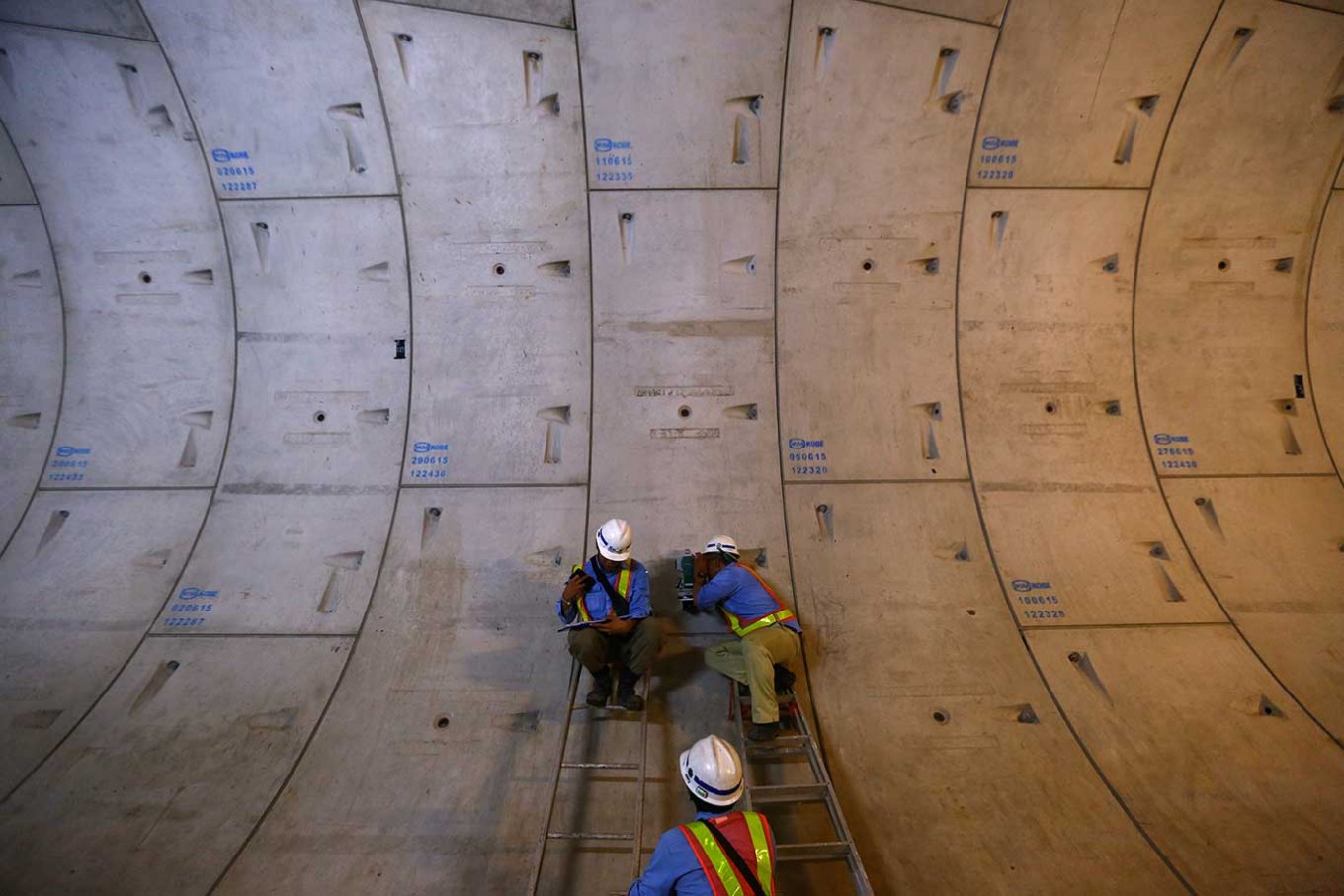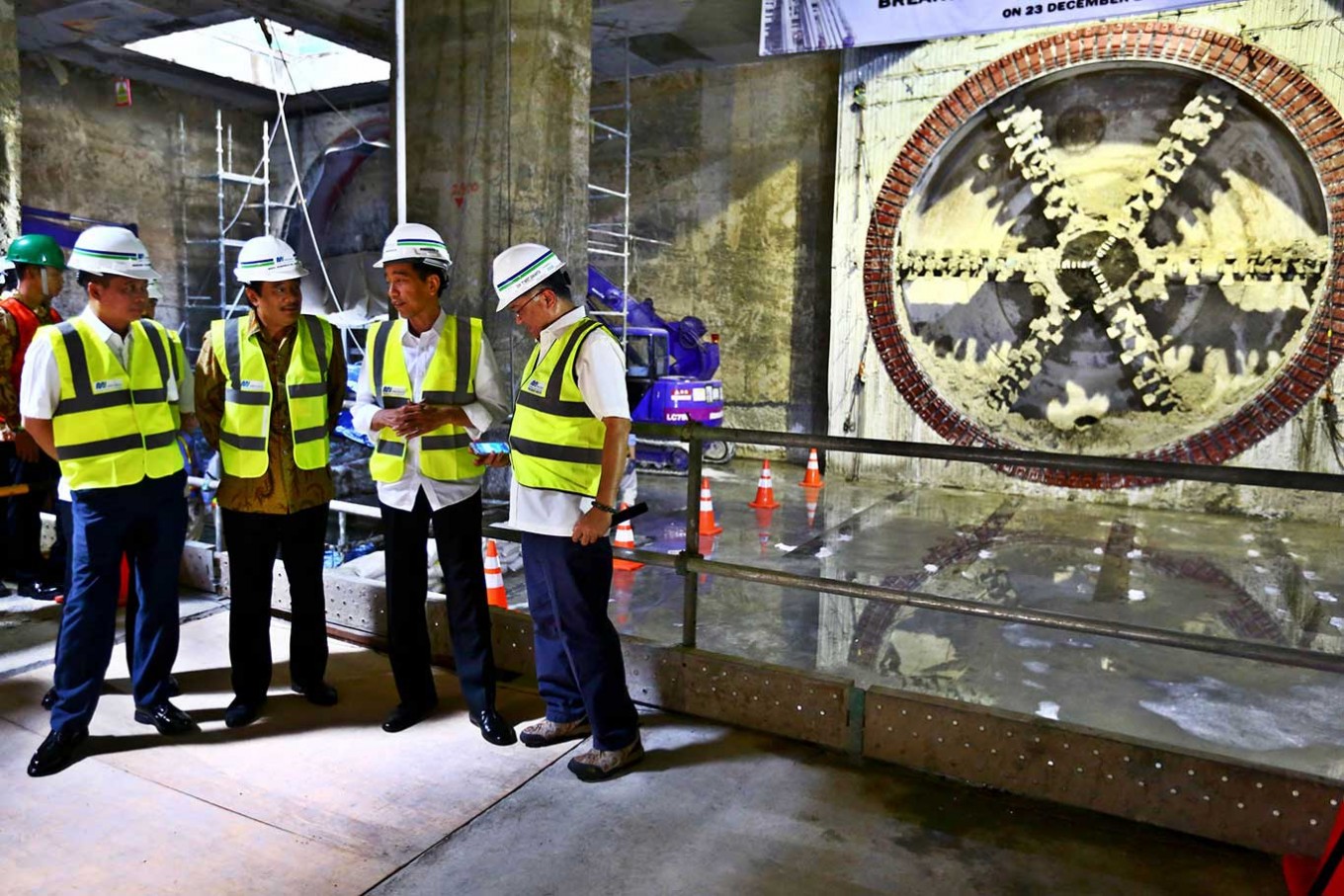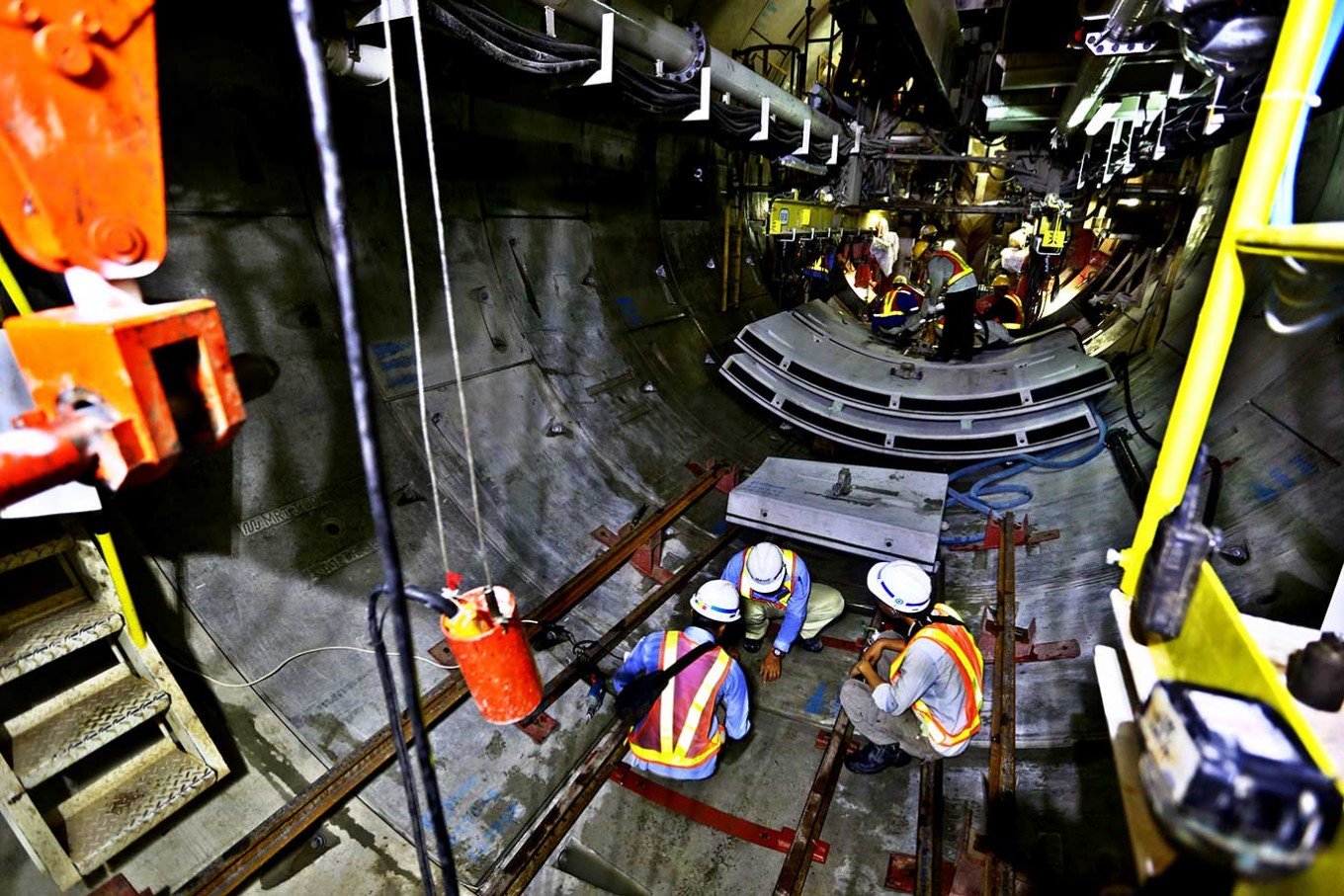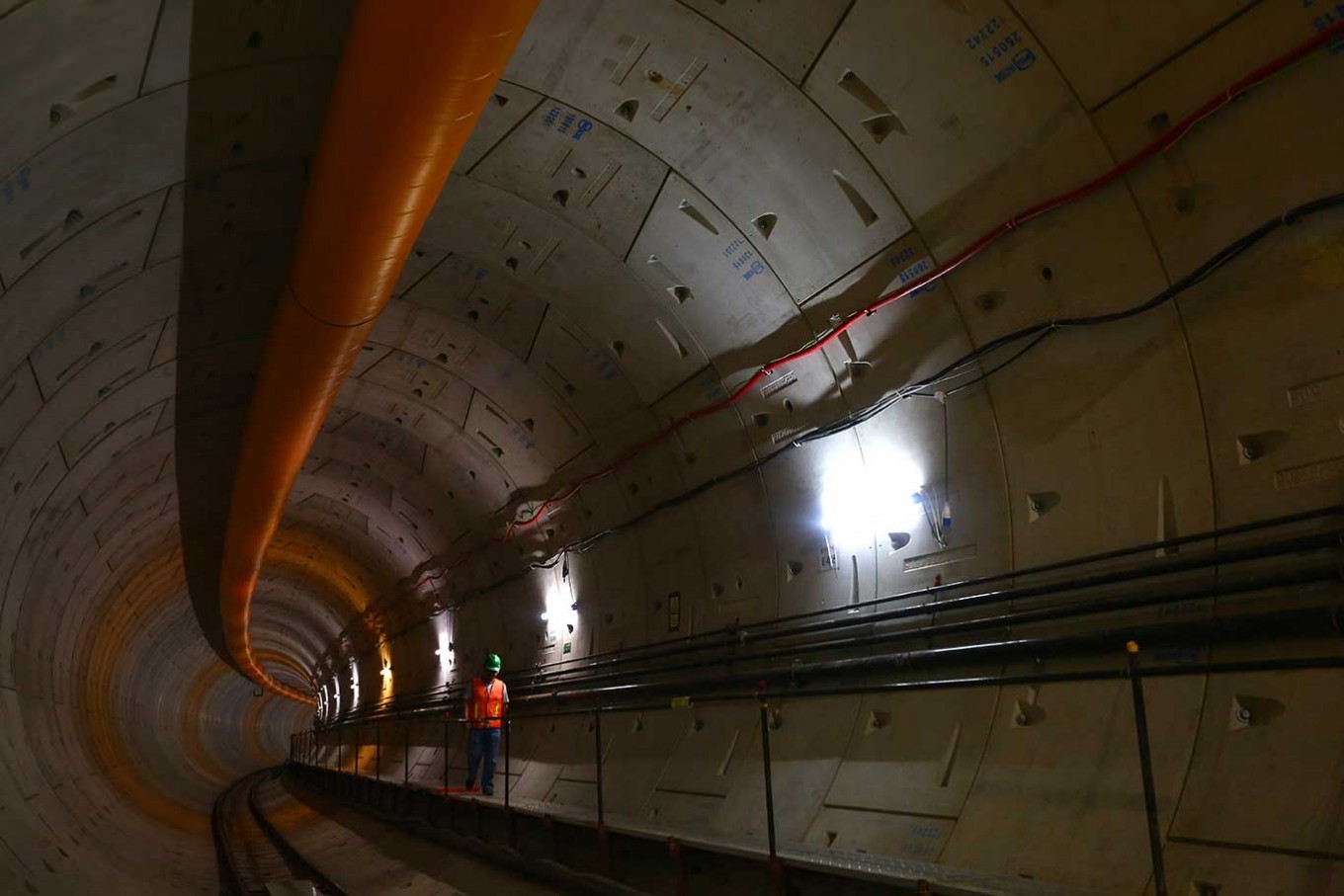The US$1.7 billion rail-based mass rapid transit (MRT) megaproject is expected to solve the traffic gridlock in the capital Jakarta. Is it safe from potential floods and earthquakes?
by Ayomi AmindoniIn the barely lit mouth of the tunnel hemmed in by the perfectly arching walls there was something almost gleaming ahead. As far as the eye could see, the curved tunnel looked flashy with lights installed along 300 meters. At certain angles it reflects a silvery white hue. It's as beautiful as a samurai sword, but not as deadly.
Along the tunnel, the air was thick and hot, like wandering into a steam bath. At the end of the tunnel, there were around 10 workers led by a foreign engineer operated a giant boring machine digging Jakarta's underground.
“This is the first MRT project in Indonesia. I am honored to work on this project,” one man said proudly.
It was Supono, a 30-year-old man who was busy installing a prism lamp in a tunnel segment located under Jl. Sudirman, one of the city's busiest streets during the daytime.
Wearing personal protective equipment and an orange helmet, the sturdy man carefully put the prism lamp in its position to make an accurate reflection to determine whether the 322-meter tunnel section was in line with its design.
“The prisms are installed at certain points, 100 meters or 20 meters, depending on the field conditions,” Supono explained with a typical Javanese accent.
He had been working on the MRT construction for half a year. Like other workers, this was his first experience constructing an underground transportation system. Previously, he worked as a surveyor on various construction projects since 2004.
“I’ve been working here since the tunnel boring machine operation started. Every day I work underground. This is my very first time working on such a construction project since there was no underground transportation project before,” he said, adding that despite the sultry conditions in the tunnel he considered the work on the capital’s first ever underground railway a privilege.
Yes, the Indonesian capital is witnessing construction of its first mass rapid rail transport (MRT) after more than two decades of postponement.
Located about five meters below the surface, the tunnel construction entrance is below the Youth Advancement Monument [Patung Tugu Pemuda] in Senayan, right in the heart of the city. This location will be a cut-and-cover area along 460 meters, a transition area where the elevated MRT goes underground. As the streets occupied by congested traffic of hundreds of automobiles and motorcycles, beneath the capital dozens of employees work 24 hours non-stop to dig a hole through the city.
The giant tunnel boring machine, which is about 6 meters in diameter, works on excavating the tunnel between six and 16 meters deep underground at a speed of 8 meters per day, removing 5 million cubic meters of material from the construction area.
The machine was operated by an efficient and effective team led by a Japanese engineer named Uzaki, who monitored it. Around him, less than six people actually operated the giant drill, while others ran a locomotive to haul the excavated materials out of the tunnel. From the Japanese engineer, the workers learned knowledge and a disciplined work ethic.
This was also tunnel surveyor Syarifuddin's first experience working on an MRT. “This is the most challenging experience I have ever met,” he said.
On a daily basis, the 36-year-old man monitored the condition of the soil, the drilling elevation, the preset coordinates of the tunnel drill and the installation of the tunnel segment monitoring rings.
When asked about the working hours, he said they used to work 24 hours a day digging into the city in two shifts. The morning shift went from 8 a.m to 8 p.m and the night shift from 8 p.m to 8 a.m. According to Syarifuddin, working the night shift was a challenge since he had to stay awake.
Nevertheless, he admitted he had a trick to avoid drowsiness.
“Coffee, of course,” he said.
Also, he added that they kept awake by alternating with other workers on the same shift. Usually there are two people working on the surface and the rest are underground.
“Our duty is only walking along the tunnel, back and forth,” he said.
 Tunnel surveyors on duty. (The Jakarta Post, Wienda Parwitasari)
Tunnel surveyors on duty. (The Jakarta Post, Wienda Parwitasari)When President Joko “Jokowi” Widodo still served as governor of Jakarta in 2012, he was eager to push ahead with the long overdue Jakarta MRT project, almost quarter of a century after the first feasibility study was done in the 1990s during the Suharto era and about 15 years since Japan offered support to construct this project.
At the same time, roads in Jakarta were growing at a rate of less than 1 percent a year while more than 1,000 automobiles a day were being added to the city streets. Traffic congestion had caused complete gridlock on several Jakarta streets on working days. The city became a parking lot.
In 2013, the governor led a groundbreaking ceremony of the first phase of the north-south corridor, a 15.7-kilometer section that is to link Lebak Bulus in South Jakarta to the Hotel Indonesia traffic circle in Central Jakarta.
The construction of the first phase was funded by a ¥125 billion (US$1.29 billion) soft loan from the Japan International Cooperation Agency (JICA). The central government agreed to repay 49 percent of the loan, while the city administration is to pay the rest over a period of 40 years, with a grace period of 10 years at an interest rate of below 1 percent.
The project is being implemented by the city administration's Daerah Khusus Ibukota (DKI) Jakarta through the land transportation authority PT MRT Jakarta, which will also be the operator of the system.
The drilling for the first phase of the MRT track started in September 2015. In his remarks, Jokowi – who by then had become President – called the subway project “a new history of transportation in Indonesia”.
 President Joko “Jokowi Widodo accompanied by Transportation Minister Ignasius Jonan and MRT president director Dono Boestami inspects the underground work of MRT on December 2015. (The Jakarta Post, Wienda Parwitasari)
President Joko “Jokowi Widodo accompanied by Transportation Minister Ignasius Jonan and MRT president director Dono Boestami inspects the underground work of MRT on December 2015. (The Jakarta Post, Wienda Parwitasari)Involving Indonesian constructing companies Wijaya Karya, Jaya Konstruksi and Hutama Karya, and Japanese companies Tokyu, Shimizu, Obayashi and Mitsui-Sumitomo, the track will have six underground stations, seven elevated stations and the capacity for up to 173,000 passengers per day. It will take less than 30 minutes from Lebak Bulus to Bunderan HI – a significant improvement on the more than one hour needed to travel this route by car during rush hour.
MRT Jakarta corporate secretary Tubagus Hikmatullah had agreed with Jokowi, claiming this project was the beginning of a new civilization. He called it a breakthrough for Indonesian transportation, especially for the capital city.
“This model can indeed provide momentum for a transportation transition in Indonesia, especially in Jakarta,” he explained.
There’s something interesting about the giant drilling machines, Hikmat said. Jokowi named the first machine after the powerful Javanese puppet figure Antareja, the third son of Bima – the second of the Pandawa brothers in the Mahabharata story.
“So, Bima had three sons, namely Gatotkaca, Antasena and Antareja. Antareja inherited the ability to live, dig, pass through, breath and even fight underground, similar to this machine that can drill through the Earth,” he explained.
As of December last year, the 6-kilometer underground section of the MRT track between Bundaran HI traffic circle and Senayan was 53 percent complete.
However, he added, the elevated section between Senayan and Lebak Bulus was only 23 percent complete. According to him, the construction of the elevated section has been delayed by land acquisition issues, with owners of the land unwilling to sell or stalling over purchase negotiations.
“We focus on work; land acquisition we leave to the provincial government.”
Hikmat added that so far the company had anticipated and addressed the problems they faced. At the beginning of the project, the problems were related to location and utilities and also to traffic management when they had to close parts of roads to allow for construction.
“But now the problems are already settled,” he explained.
The company has also conducted an engineering study for the second phase of the north-south MRT line, an 8.1-kilometer section linking the Hotel Indonesia traffic circle to Kampung Bandan in North Jakarta. This project is planned to start next year and is expected to be completed in 2020. The east-west line is expected to start operation in 2027.
 Pumps procurement and good water management is necessary to address the threat of flooding in the underground. (The Jakarta Post, Wienda Parwitasari)
Pumps procurement and good water management is necessary to address the threat of flooding in the underground. (The Jakarta Post, Wienda Parwitasari)Threats
Greater Jakarta's estimated population was 30.53 million people in a land area of 3,224.5 square kilometers. That makes the density of this megacity 9,468 people per square kilometer, according to Demographia’s 2015 World Urban Areas survey.
Greater Jakarta is one of the world’s fastest growing urban areas and has prospects for even stronger growth. The United Nations predicted the Greater Jakarta population would double over the next 40 years. For an already crowded Jakarta, this is bad news.
There are other massive problems. Jakarta is located on a lowland by the Java Sea and has severe drainage and flooding problems. Rising sea levels could make Jakarta's problems even worse.
The geographic conditions of Jakarta have made the city synonymous with flooding. The combination of land subsidence, poor water governance and the trend of rising sea levels causing floods are the biggest challenges in the capital. Looking ahead, the capital also should be wary of the threat of a massive earthquake at any time.
Experts have predicted the potential for a large earthquake in Jakarta. In 1699 Batavia – the prior name of Jakarta – was rocked by an earthquake with an estimated strength of 8 to 9 on the Moment Magnitude (MM) scale, with an epicenter under Java Island.
With a more than 10 million daytime population and skyscrapers in every corner of the city, the impact could be very deadly if a massive quake happens again in Jakarta.
 Carrying out a large construction project like an MRT system in the middle of congested Jakarta is a herculean task. (The Jakarta Post, Wienda Parwitasari)
Carrying out a large construction project like an MRT system in the middle of congested Jakarta is a herculean task. (The Jakarta Post, Wienda Parwitasari)A geologist with the Indonesian Geologist Association (IAGI), Rovicky Putrohari Dwi, said Jakarta was a lake in ancient times, making Jakarta's soil soft and consisting of sediment. As a result, if a large-scale tectonic earthquake occurred on a fault under southern Java, great damage will be occur in Jakarta because of the amplification of the tremor.
“Sedimentary soil makes the tremors vibrate more in Jakarta during an earthquake in the south of Java.”
These geographical threats prompted the question: Is it safe to ride the metro in Jakarta?
“It’s safe,” he said. “Although not 100 percent safe.”
Nevertheless, he continued, it can be anticipated if the project was built with earthquake-resistant materials.
“Contractors should be willing to spend extra,” Rovicky said.
To address the threat of flooding in the underground, he continued, there should be an engineering treatment, ranging from procurement of pumps and good water management.
"So that water can be channeled elsewhere. But since the drainage on the surface is bad, there is still a lot of puddles. Therefore, there should be anticipation of flooding in the underground.”
Better late than never
To give a better understanding about the project, MRT Jakarta allowed the public to visit and meet Indra Bambang Utoyo, a Bandung Institute of Technology (ITB) civil engineering alumni, along with a group of engineers who are also alumni of ITB's class of 1973.
Indra, who is also a Golkar Party executive, praised this project as a breakthrough, not only in terms of mass transportation, but also for Indonesian engineering. After knowledge is transferred from Japan, he said, more tunnels will be built using this kind of technology.
“This time, by our engineers,” he said.
Similar to President Jokowi and Hikmat, Indra believed this megaproject will be the beginning of Indonesia's new mass transportation, although a little late. He considered the postponement of this project because of a lack of decisiveness on the part of the previous government in addressing the acute traffic congestion in the capital. It was a fatal error, he said.
“If we had started the project 10 years ago, it would be completed by now, but at least it is better late than never.”
 The underground MRT stations to be completed late 2016. (The Jakarta Post, Wienda Parwitasari)
The underground MRT stations to be completed late 2016. (The Jakarta Post, Wienda Parwitasari)Famous for its efficiency and security, he believed the Japanese technology would ensure the safety of the metro once it starts operating. Earlier, some parties questioned the safety of underground transport modes because of the severe flooding in Jakarta.
“This technology has been used in many countries and it has taken the anticipation of floods and earthquakes into account. So for me this is a cutting-edge technology for Indonesian engineers to learn. They really should learn from this project,” he said.
Floods will still be a big challenge for Jakarta since Jakarta lies in a lowland area through which 13 rivers flow. High tides in the coastal area will also still generate floods. Land subsidence is likely to continue and will pose more threats for severe flooding in Jakarta.
Indeed, carrying out a large construction project like an MRT system in the middle of congested Jakarta is a herculean task. The MRT construction is just a beginning. The next step, which is critical for Jakarta’s success in easing traffic, is to change people's lifestyle from using private vehicles to riding the MRT.
The idea of developing a mass transportation system is to reduce the numbers of motorcycles and private cars. However, Jakarta's middle class seems reluctant to use public transportation.
When asked about this matter, Deden Rukmana, an associate professor and coordinator of the Urban Studies and Planning Program at Savannah State University said we need to actively attract car users and motorcyclists to use MRTs. Electronic road pricing and high parking fees could reduce the use of private cars. The biggest challenge for Jakarta is to convert motorcyclists into MRT riders.
“It would be a long paper to discuss this task,” he said.
He, however, believed Jakarta’s traffic woes would be decreased in the next decade if the MRT project is completed and expanded.
“I believe that the MRT is the main ingredient for alleviating traffic woes in megacities particularly Jakarta,” Deden explained, adding that Jakarta needs to integrate this expensive project with the Transjakarta busway system, the public Metromini and Kopaja minibuses, public minivans and the city buses to ease its traffic congestion.
[gal:6]
Aside from developing the MRT, Deden continued, Jakarta needs to implement other innovative methods to ease traffic congestion, including electronic road pricing, shuttle services, carpool matching services, telecommuting, downzoning and better parking management in downtown areas.
“Jakarta also needs to implement and develop TOD (transit-oriented development) and to have more areas with a mix of land uses and an interconnected network of streets designed to encourage walking and bicycling,” he mentioned.
Compare to neighboring country like Singapore, Malaysia, or Thailand that already have metros, Deden said, our country has been left behind. Bangkok developed its MRT in 2004 and reduced significantly its traffic problems. Manila (1984), Singapore (1987), Kuala Lumpur (1995) have developed their MRTs and expanded their networks. The MRTs in those Southeast Asian capitals have become the backbone of their transportation system.
“Jakarta needs to catch up with those capitals,” he said firmly.
At least Jakarta could learn from the success story of Singapore’s MRT. Often cited as a case study in sustainable and successful urban transportation development, the neighboring country applied efficiency to its MRT system construction. At more than 20 years old, the general cleanliness and orderliness of the system are still impressive. Singapore’s MRT is Southeast Asia’s second oldest metro after Manila's LRT.



